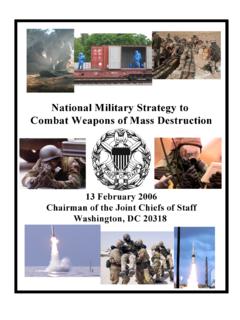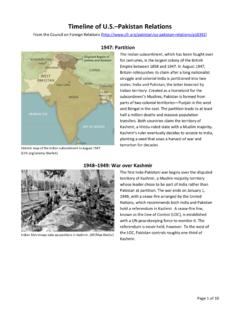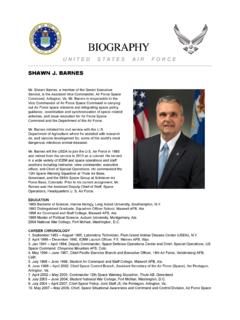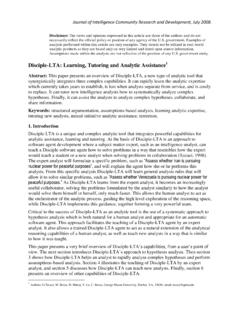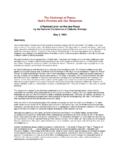Transcription of An Extended Deterrence Regime to Counter …
1 AAnn EExxtteennddeedd DDeetteerrrreennccee RReeggiimmee ttoo CCoouunntteerr IIrraanniiaann NNuucclleeaarr WWeeaappoonnss IIssssuueess aanndd OOppttiioonnss Richard L. Kugler Center for Technology and National Security Policy National Defense University September 2009 iiThe views expressed in this article are the author s and do not reflect the official policy or position of the National Defense University, the Department of Defense, or the Government. All information and sources for this paper were drawn from unclassified materials. Dr. Richard L. Kugler is a senior consultant and former Distinguished Research Professor at the Center for Technology and National Security Policy (CTNSP), National Defense University.
2 His specialty is defense strategy, global security affairs, and NATO. He advises senior echelons of the Office of the Secretary of Defense, the Joint Staff, and the interagency community. He is the author of multiple books, journal articles, and official studies on defense strategy and programs as well as NATO and global security affairs. Dr. Kugler has his doctorate from the Massachusetts Institute of Technology. A former Pentagon senior executive and RAND research leader, he is one of the original architects of NATO enlargement and multiple other initiatives in national security policy.
3 He is a recipient of the Distinguished Civilian Service Medal and other awards and decorations. Defense & Technology Papers are published by the National Defense University Center for Technology and National Security Policy, Fort Lesley J. McNair, Washington, DC. CTNSP publications are available at < >. iii Contents Executive Summary .. v 1 A New and Unpolished Idea: The Need for Careful Analysis .. 1 Purposes of Paper .. 2 Overarching 4 Lessons from the Cold War .. 8 Strategic Threats and Dangers Posed by a nuclear -Armed Iran .. 11 Designing an Extended Deterrence Regime Ends, Ways, and 15 Choosing Ways: Crafting the Methods and Mechanisms of Deterrence .
4 21 Deterring Iran .. 22 Reassuring Friends and Allies, and Forging Common Security 27 Selecting Means Blending the Instruments of 30 Assessing Options Balancing Political Feasibility and Strategic Performance .. 38 Conclusions and Recommendations .. 50 ivTable 1. Elements of a Possible Extended Deterrence Regime Countries/Actors to be Protected Threat to be Deterred CONUS/ Deployed Forces NATO/Europe Israel Friendly Arab/ Muslim Countries nuclear Missile Attack High priority High priority/NATO Treaty commitment High priority/ existential threat High-to-medium priority nuclear Terrorism and Proliferation High priority High priority/NATO Treaty commitment High priority/ Existential threat High-to-medium priority Conventional Military Attack Low risk/ low emphasis Low risk/ low emphasis Low risk/ low emphasis Medium-to-high priority Political Coercion Low risk/ low emphasis Low risk/ low
5 Emphasis Medium risk/ medium emphasis Medium-to-high priority Conventional Terrorism Low risk/ low emphasis Medium risk/ medium emphasis High risk/ high priority Medium-to-high priority Table 2. Mechanisms and Instruments of Extended Deterrence Threat to be Deterred Strategic Mechanisms for Pursuing Deterrence Key Instruments for Carrying out Mechanisms of Deterrence nuclear Missile Attack y Make clear gravity of event y Prevent successful missile attack y Credibly threaten nuclear retaliation y Strong declaratory policy y Missile defenses of protected countries y nuclear retaliatory capabilities and options nuclear Terrorism and Proliferation y Make clear gravity of event y Prevent nuclear terrorist attack y Credibly threaten nuclear retaliation y Strong declaratory policy y Homeland security and attribution assets y
6 nuclear retaliatory capabilities and options Conventional Military Attack y Make clear and Regime will respond appropriately y Conventional defense against specific threats y Capacity to conduct Counter -attacks y Diplomatic collaboration among Regime members y Allied capabilities to defend borders, airspace, and sea lanes y Conventional forces for spectrum of Counter -attacks y conventional commitments, when appropriate Political Coercion y Deny Iran opportunities and benefits of political coercion y Protect vulnerable Regime members from coercion y Impose political, diplomatic, and economic costs on Iran y and Regime -wide political support of vulnerable countries y Reduce vulnerabilities of exposed countries through diplomatic collaboration y Wide array of instruments to exert Counter -pressures on Iran Conventional Terrorism y Deny Iran opportunities and benefits of conventional terrorism.
7 Y Protect vulnerable Regime members. y Impose political, diplomatic, and economic costs on Iran. y Homeland security efforts, individual and multilateral. y Diplomatic collaboration among Regime members to discourage terrorism. vExecutive Summary This paper examines the idea of creating an American-led Extended Deterrence Regime in the Middle East to address potential Iranian acquisition of nuclear weapons and missiles. It does not focus on how to prevent Iran from becoming a nuclear -armed power. Instead it addresses how the Government can act to deter Iran in a future setting where it already possesses these weapons and is trying to employ them to geopolitical advantage.
8 Developing a coherent strategy can lessen the risk that the United States will be surprised, compelled to improvise, and unable to lead effectively in the Middle East and elsewhere. Even as the Administration employs diplomacy, sanctions, and multilateral cooperation to derail Iran from the nuclear path, it should also develop a clear sense of how it will react if, as is possible, Iran emerges as a nuclear power, led by a radical government with a menacing foreign policy. Secretary of State Hillary Clinton recently stated that Iran should consider the consequences of a defense umbrella over the region.
9 This paper explores many of the issues related to such an umbrella. Key questions arise regarding an Extended Deterrence Regime . What Iranian threats would this Regime try to deter? Who would it protect, and how would it protect them? How much Deterrence is possible, and how much is enough? What shape would a Deterrence Regime take, how would it operate, and would it be effective? What options are available? This paper addresses these and related questions. Its intent is to illuminate issues and options, not to advocate any single approach. The recent tumultuous election in Iran has restored President Ahmadinejad to power in a setting of strong dissent and growing government repression.
10 Should Iran verifiably forsake its nuclear weapons program, an Extended Deterrence Regime would be unnecessary. But if Iran continues to pursue development of nuclear weapons and delivery systems, the United States may have little other choice than to seek to create a Deterrence Regime , because a nuclear -armed Iran would pose serious threats to Europe, Israel, and friendly Arab/Muslim countries in the Middle East. Creating such a Regime could serve key strategic goals and is preferable to the alternatives of going to war with Iran or acquiescing to its menacing strategic designs.



